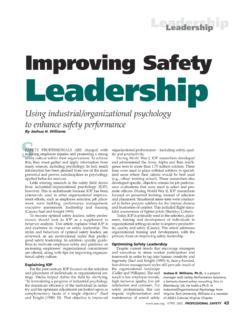Transcription of Tales from Twelve O’Clock High: Leadership Lessons for the ...
1 1 Tales from Twelve O'Clock high : Leadership Lessons for the 21st Century by Major Attila J. Bognar The year is 1942. The place: Archbury Airfield, England. The American 918th Bomber Group has just returned from another mission against German targets in France. The 918th's performance continues to be dismal. The unit cannot put steel on target and is experiencing unusually high aircraft and crew losses. Bad weather and having to conduct daylight low-altitude bombing missions contribute to the group's poor performance . However, the 918th's weak demonstrations sharply contrast with the other three 8th Air Force bomber groups' general success.
2 As a result, the 918th is suffering from significantly poor morale. More and more men are making excuses to miss duty. Because of its difficulties, the 918th has the reputation of being the "hard luck" unit. Despite this, the 918th's men greatly respect their commander, Colonel Keith Davenport. Davenport is their friend and confidant; he can do no wrong. Davenport sees his unit's failures as resulting from impossible missions, dictated from higher headquarters, which he believes places inordinate demands on his men's abilities. Davenport believes higher headquarters has lost touch with reality, especially in understanding the tragedy of losing good men.
3 Concerned about the 918th's performance , 8th Air Force Commander General Pritchard personally visits Davenport. Accompanying Pritchard is Operations Officer Brigadier General Frank Savage. In a tense conversation, Davenport emotionally relates his concerns. Ultimately, Pritchard relieves Davenport, and Savage assumes command of the 918th. So begins the classic World War II movie Twelve O'Clock high . Many viewers will at first find this film to be just another good vintage war movie. However, on examination, it becomes a superb treatise on understanding the "charismatic Leadership " paradigm, which will play an important role in the Army's future.
4 As the Army enters the 21st century, dramatic changes will occur in its force structure, organization, equipment and missions. Budgets will continue to shrink while deployments will become more frequent. With these changes, the need for superb, unwavering Leadership will remain constant. By studying Savage's conduct and actions, Army leaders can thoroughly grasp the charismatic leader paradigm's basic concepts. Charismatic Leadership Charismatic Leadership is perceptual in In The Spellbinders: Charismatic Political Leadership , Willner says charisma is not based on personality or context. "It is not what the leader is but what people see the leader as that counts in generating the charismatic relationship.
5 "2 Charisma, then, might be attributional in nature. That is, followers might assign a leader charismatic qualities based on how they perceive his Essentially, the charismatic leader is dependent on perceived behaviors or attributes in order to remain in This aspect is particularly important since charismatic attributions are binary-either a follower perceives charismatic behaviors or he does not. Also, a charismatic leader to one follower may not be a charismatic leader to another. Charisma, from Greek, means "gift from the gods." The German sociologist Max Weber used the word to describe a leader who could attain legitimacy, not through rules or traditions but by possessing qualities that endowed the leader with supernatural, superhuman or exceptional powers or qualities.
6 Weber asserts that followers choose to accept the charismatic leader on the basis of his emotional Author House made one of the first attempts to demystify the charismatic leader by identifying specific traits and behaviors: self-confidence, the need to influence oth ers and a strong conviction in his beliefs. House also determined a charismatic leader's followers exhibit implicit trust, obedience, affection and acceptance of the Followers also held beliefs similar to the leader's and were highly involved in the organization's mission, believing they were essential to its Willner attributed the charismatic leader's success to his ability to create and foster an inspirational vision as well as to build confidence in followers through excellent rhetorical ability and a powerful 2 Researcher Bass revived charisma's mystical aspect by asserting that the charismatic leader views himself as having a special or supernatural purpose and that followers see the charismatic leader as larger than Bass also identifies charismatic leaders as possessing energy, self-confidence, self-determination, insight, eloquence, freedom from internal conflict, assertiveness.
7 Emotional expression, ambition and the ability to seize Similarly, Conger and Kanungo say the charismatic leader is also exemplary, unconventional, radical, willing to take risks and often emerges at times of crisis or The charismatic leader's most significant attribute is his ability to create a compelling vision that followers readily accept and The vision acts as a focal point to energize followers to accept organizational changes and commit to new ideals. Although a charismatic leader can inspire great commitment, sacrifice and energy, there is no guarantee his vision is In fact, some Leadership scholars warn of charisma's "dark side," where unethical charismatic leaders, such as Adolf Hitler and Joseph Stalin, use their visionary abilities for self-serving purposes with little regard for their followers' Charisma and Transformational Leadership In 1987, Burns first described the concept of transformational Leadership and further developed Weber's notion of the charismatic leader by postulating a leader able to change or transform his followers' actions and behaviors.
8 In defining the transformational leader, Burns found it necessary to define the transactional Transactional Leadership relies on a series of exchanges or bargains between the leader and follower. The transactional leader primarily relies on the follower's compliance, which leads the follower to do what the organization expects of him. However, while the follower might comply with the leader in exchange for a reward, he might exhibit little commitment to the leader or organization. Unlike compliance, commitment is a process by which the follower does whatever it takes to better the organization, including personal sacrifice. As a result, a follower often does not share the transactional leader's beliefs, but rather, tolerates them, since the leader has the power to reward or Many Leadership scholars associate the transactional leader with the stereotypical manager, who dictates tasks to his followers and ensures they do such tasks correctly.
9 Based on a follower's performance , the transactional leader administers rewards and penalties as well as provides discipline when necessary. Because of the managerial functions associated with the transactional leader, such a leader tends to maintain the status quo and is largely responsible for the bureaucratic aspects within an organization as he focuses on planning, budgeting, organizing and controlling. Conversely, transformational Leadership is largely associated with the term "leader."17 Perhaps the greatest difference between the transactional and transformational leader-the manager and leader, respectivelyis that "the manager does things right; the leader does the right thing.
10 "18 In this sense, transformational Leadership is based on more than follower compliance; it includes shifts in the follower's beliefs and values. Followers internalize the transformational leader's end values, such as integrity and honor, and commit themselves to the leader and his As a result, transformational Leadership is built on follower commitment. Such a commitment cascades from the highest to the lowest levels in an organization, inevitably affecting all aspects of an organization's Furthermore, in gaining follower commitment, the transformational leader focuses on long-term goals, inspires followers to share his vision, enacts change and empowers Transformational and charismatic leaders have many attributes in common.








